Paddle Plant (Kalanchoe Lucia) Care & Propagation Guide
Written by Iris
Oct 19 2021
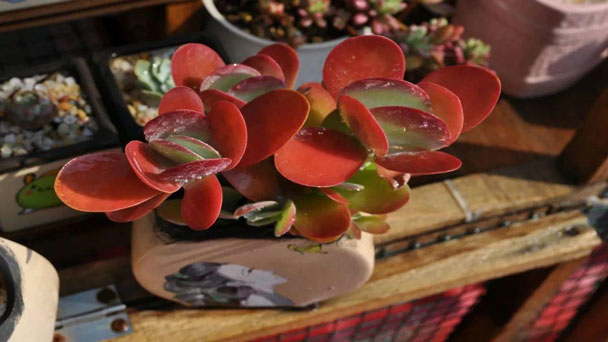
Paddle Plant (Kalanchoe Luciae) is a perennial succulent plant. The stems are thick, the stems are off-white, the leaves are obvate, closely arranged, the leaves are light green or yellow-green, and there is a thick layer of white powder. When the sun is full in spring and autumn, the leaf margins will turn red. It blooms in spring, the flowers are relatively small, and the flower color is yellow.
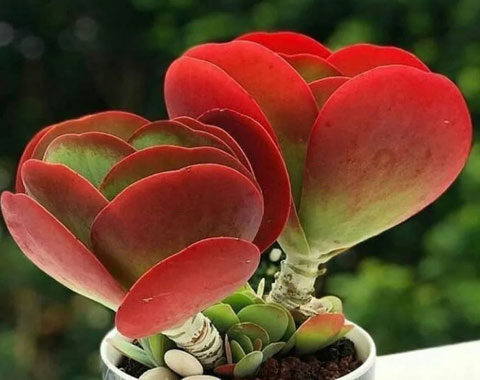
When taking a leaf for propagation, gently twist the leaf from the stem. Be sure that the leaf you get is a “clean pull,” where no part of the leaf is left on the stem. This will give you a better chance of a successful propagation.
Allow the leaf to callous over for a day or two before placing it on well-draining soil.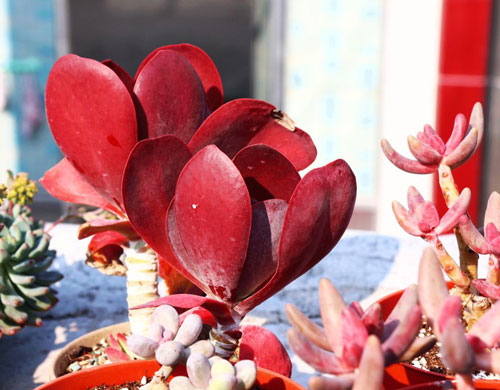
During the cool winter months, give paddle plants as much sunlight as possible. Strong sunlight helps to bring out the beautiful red coloring on the Paddle plants leaves. Paddle plants will also grow in the shade. However, you’ll notice that the succulent foliage loses its red tinges and becomes a pale jade green color. The rounded obovate leaves will also become elongated as the leaves stretch toward the light.
To create a succulent soil mix for paddle plants, combine two parts of regular potting soil, one part perlite, and one part of coarse horticultural sand. This potting mix allows water to drain super quickly but retains some moisture to keep the succulent roots healthy. You can also amend the succulent potting mix for desert plants by adding extra sand. For growing paddle plants indoors, it's best to grow them in terracotta pots. The porous material allows the soil to dry quicker and helps prevent any issues with excessive soil moisture.
To prune a paddle plant, use sterilized equipment to cut the stems near the soil line. On a stem, you may have several succulent leaves that look like a cabbage rosette. You can then use leaf cuttings to propagate new leaves.
Should you let paddle plant flower? Many people consider the tubular Kalanchoe flowers as insignificant and not worth keeping. Snipping off the flower stalk helps keep the succulent's growth compact. So, cutting the flowers won't harm the paddle plant and may even speed up growth.
Overwatering or excessive fertilizing can lead to problems with powdery mildew, root rot, mealybug succulent pests, plant scale and mites.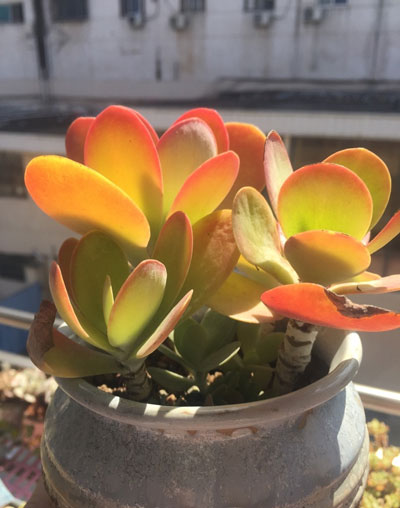
To resolve powdery mildew on succulent plants, wipe the leaves with some diluted milk. Then, only water the succulent soil when it's dry and keep the paddle plant away from humid rooms.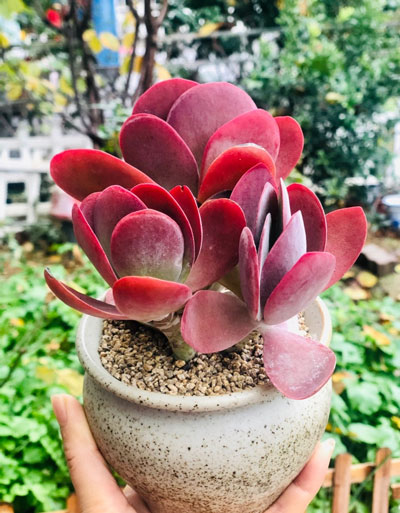
Where to Grow Paddle PlantHow to Propagate Paddle Plant (Kalanchoe Luciae)Paddle Plant Propagation with SeedsPaddle Plant Propagation with Stem CuttingsPaddle Plant Propagation with Leaf CuttingsHow to Care for Paddle Plant (Kalanchoe Luciae)Paddle Plant Light CarePaddle Plant Soil CarePaddle Plant Water CarePaddle Plant Temperature & Humidity CarePaddle Plant Fertilizer CarePaddle Plant Pruning CarePaddle Plant Pests & Diseases CarePaddle Plant (Kalanchoe Luciae) FAQIs Paddle Plant Considered Toxic Or Poisonous To People, Kids, Pets?Are Paddle Plant Considered Invasive?Why are my paddle plant leaves curling?What is white powder on a paddle plant?
Where to Grow Paddle Plant
Paddle Plant (Kalanchoe Luciae) is not cold-hardy, so if you live in a zone that gets colder than 20° F (-6.7° C), it's best to grow Paddle Plant succulent in a container that can be brought indoors. It does well in full to partial sun. Plant in an area of your garden that gets 6 hours of sunlight a day.
How to Propagate Paddle Plant (Kalanchoe Luciae)
The easiest way to propagate Paddle Plant (Kalanchoe Luciae) is to plant leaves or leaf cuttings in spring or summer. Set leaves or cuttings aside for a couple of days, or until the cut end develops a callus. You can also remove offsets that grow on the side of a mature paddle plant. Plant the leaves or offsets in a small pot filled with lightly moistened potting mix for cacti and succulents. Keep the potting mix evenly and lightly moist but never soggy. Bright, indirect sunlight is best for paddle plant propagation. Once the plant is established and shows healthy new growth, you can treat it as a mature plant.Paddle Plant Propagation with Seeds
“Flapjack” will produce small offsets. Cut the offsets off from the main stem with a sharp, sterile knife or scissors. Allow the offsets to dry for one to two days before laying on well-draining soil.Paddle Plant Propagation with Stem Cuttings
To propagate Kalanchoe luciae “Flapjack” from cuttings, use a sterile, sharp knife or pair of scissors. Remove a leaf from the main plant, and allow it to callous for several days before placing on well-draining soil. Water whenever the soil has dried out completely.Paddle Plant Propagation with Leaf Cuttings
It is possible to propagate Paddle plant from leaves, but it can be difficult.When taking a leaf for propagation, gently twist the leaf from the stem. Be sure that the leaf you get is a “clean pull,” where no part of the leaf is left on the stem. This will give you a better chance of a successful propagation.
Allow the leaf to callous over for a day or two before placing it on well-draining soil.

How to Care for Paddle Plant (Kalanchoe Luciae)
Paddle Plant Light Care
Paddle plants (Kalanchoe Luciae) grow best in bright light. The best place to grow a paddle plant is on a sunny windowsill. It's a good idea to protect the succulent from intense, direct sunlight to prevent leaf scorch during the summer.During the cool winter months, give paddle plants as much sunlight as possible. Strong sunlight helps to bring out the beautiful red coloring on the Paddle plants leaves. Paddle plants will also grow in the shade. However, you’ll notice that the succulent foliage loses its red tinges and becomes a pale jade green color. The rounded obovate leaves will also become elongated as the leaves stretch toward the light.
Paddle Plant Soil Care
Like caring for most succulents, a paddle plant (Kalanchoe Luciae) must grow in loose, aerated, sandy soil that has excellent drainage. You should ensure that the soil dries out relatively fast between watering. The key to a healthy paddle plant growth is draining holes in the pot to allow water to drain freely.To create a succulent soil mix for paddle plants, combine two parts of regular potting soil, one part perlite, and one part of coarse horticultural sand. This potting mix allows water to drain super quickly but retains some moisture to keep the succulent roots healthy. You can also amend the succulent potting mix for desert plants by adding extra sand. For growing paddle plants indoors, it's best to grow them in terracotta pots. The porous material allows the soil to dry quicker and helps prevent any issues with excessive soil moisture.
Paddle Plant Water Care
Water Paddle plant (Kalanchoe Luciae) thoroughly, then allow top 2 inches of soil to dry out between waterings. Don't allow soil to get soggy or the roots may rot. Avoid getting the leaves wet to prevent rot. Water the potting mix or water from the bottom. Remember to always use room-temperature water when watering your house plants.Paddle Plant Temperature & Humidity Care
Paddle Plants, like most succulents, thrive in dry and hot regions. They aren't cold-hardy, and this is why they're most often kept as house plants. If winter temperatures drop below 20 degrees Fahrenheit, keeping them as an indoor plant, or bringing them inside over winter is recommended. They're also not suited to very humid climates. Their natural environments are dry, arid landscapes.Paddle Plant Fertilizer Care
Your Flapjack Succulent will appreciate being fed a balanced and diluted fertilizer during its growth period over the spring and summer. Once every couple of months should be more than enough. Over-fertilizing, just like over-watering, can result in root rot or the formation of powdery mildew on these succulents.Paddle Plant Pruning Care
Pruning paddle plants helps remove leggy growth and to propagate using the leaves. A mature paddle plant can also have dense growth that can crowd out the offsets or baby plants. Some plant experts recommend pruning flower stalks to concentrate the plant's energy in growing the fleshy leaves.To prune a paddle plant, use sterilized equipment to cut the stems near the soil line. On a stem, you may have several succulent leaves that look like a cabbage rosette. You can then use leaf cuttings to propagate new leaves.
Should you let paddle plant flower? Many people consider the tubular Kalanchoe flowers as insignificant and not worth keeping. Snipping off the flower stalk helps keep the succulent's growth compact. So, cutting the flowers won't harm the paddle plant and may even speed up growth.
Paddle Plant Pests & Diseases Care
Paddle Plant (Kalanchoe Luciae) experiences little or no disease or pest problems as long as the plant is properly watered and receives plenty of sun and good air circulation.Overwatering or excessive fertilizing can lead to problems with powdery mildew, root rot, mealybug succulent pests, plant scale and mites.

Paddle Plant (Kalanchoe Luciae) FAQ
Is Paddle Plant Considered Toxic Or Poisonous To People, Kids, Pets?
All parts of the paddle plant are quite toxic and should be kept out of the reach of children and pets. Wear gloves and long sleeves when handling the plant. Wash up promptly.Are Paddle Plant Considered Invasive?
There are many different species of Kalanchoe, and all are considered invasive in areas where they are winter hardy, such as Florida.Why are my paddle plant leaves curling?
Watering or light issues are usually to blame for paddle plant leaves starting to curl. Flapjack paddle plants grow best in dry, sandy soil and need to be watered occasionally. Also, the potted succulent should grow in bright light, and some direct sunlight is fine. Try to avoid growing paddle plants in shaded or dark rooms. Read Next: How to Care for Paddle Plant Leaves Curling ProblemWhat is white powder on a paddle plant?
Paddle plants (Kalanchoe Luciae) usually have a light white powder-like coating on their fleshy blue-green leaves. However, if the soil has been damp and the leaves appear discolored with a white powdery coating, the problem could be powdery mildew.To resolve powdery mildew on succulent plants, wipe the leaves with some diluted milk. Then, only water the succulent soil when it's dry and keep the paddle plant away from humid rooms.

Latest Updated
- Benefits of Bugleweed - 7 Science-backed Health Benefits
- Bugleweed Dangers & Side Effects - Is It Poisonous?
- How to Plant Evergreen Trees - What You Should Know
- When to Plant Evergreens - Grow Guide for Evergreen Trees
- 12 Wonderful Evergreen Shrubs for Your Garden
- 12 Popular Evergreen Plants with Pictures for Beginners
- When And How To Prune A Lilac Bush Like a Pro
- How to Grow & Care for Lilac Vine (Hardenbergia Violacea)
- Japanese Lilac Tree (Syringa Reticulata) Care & Propagation Guide
- Shumard Oak Pros and Cons - What to Know
Popular Articles
- Winter maintenance of Antirrhinum Majus
- How to Grow Terminalia Mantaly Tree
- How to Grow and Care for Crossostephium Chinense
- How to grow Antirrhinum Majus in spring
- Peristeria Elata (Dove Orchid) Profile: Info & Care Guide
- Underwatered Snake Plant (Sansevieria Trifasciata) - Signs And How To Fix
- How to Care for Brazilian Jasmine Plant (Mandevilla Sanderi)
- How to Grow & Care for Graptopetalum Purple Delight in Summer
- Rosa Chinensis (China Rose): Plant Growing & Care Tips
- How to Care for Baby Sun Rose (Aptenia Cordifolia)